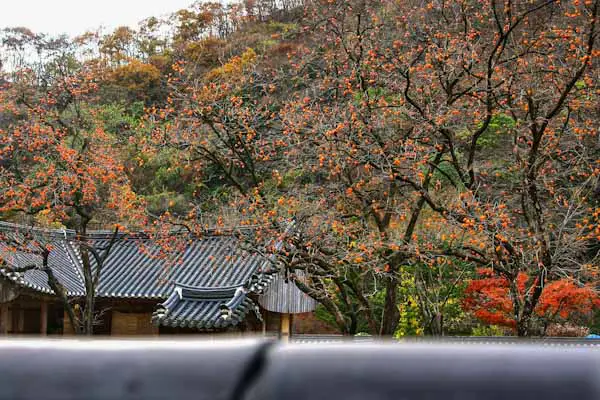
Persimmon trees have a long history both in Asia and North America. They have been in cultivation in China for more than 2000 years, and there are stories of persimmon trees in Japan living now that are over 400 years old. Of course, trees that old also tend to get quite large. But what about the average backyard persimmon tree? How big should you expect your persimmon tree to grow?
Persimmon trees typically grow to be as large as 70 feet, depending on variety. American persimmons (Diospyros virginiana) average 30 to 70 feet tall. Asian persimmons (D. kaki) grow to be 12 to 30 feet. Other persimmon varieties (D. texana, digyna, lotus, etc.) range from 10 to 50 feet tall, or more.
The height of a persimmon tree depends on its species type, cultivar, location, and age. Before choosing a planting location, it helps to know how how big the tree will grow. How quickly will it reach maturity? Is there anything you can do to control a persimmon tree’s height? In this article we’ll answer all of your questions about persimmon tree size.
The Size and Spread of a Persimmon Tree
Diaspyros virginiana, also called common or American persimmon, is native to eastern North America. It was discovered by Captain John Smith in 1609 when he travelled to what is now Virginia. These trees grow much larger than the Asian varieties.
American persimmons typically mature to be 30 to 70 feet tall (9 to 21 meters), with a 25 to 30-foot spread. According to Monumental Trees, the tallest D. virginiana on record at the time of writing this article is over 80 feet (26.2 meters) tall.
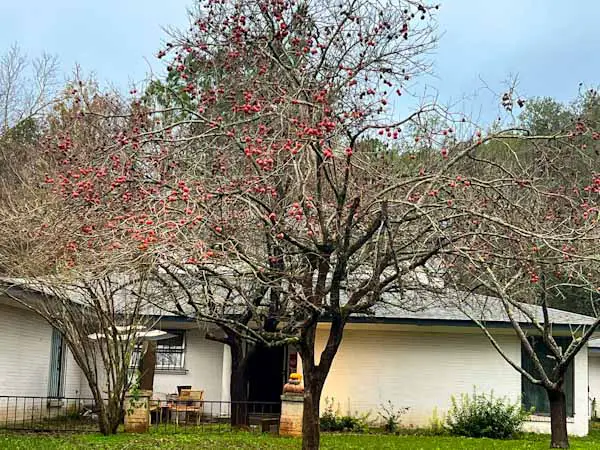
Compared to the native American varieties, Asian persimmons (Diospyros kaki) are much smaller. Even the largest varieties will only grow to be about 12 to 30 feet (3.5 to 9 meters) with up to a 25-foot spread. The tallest Asian persimmon currently recorded is in Slovakia, and as of 2020 it was just over 29 feet.
Related: American vs. Asian Persimmons: What’s the Difference?
American and Asian persimmons are the two most common types to grow, but there are more. Texas persimmon, Diospyros texana (also known as Mexican persimmon, D. mexicana, or commonly as “black persimmon”) is a shrubby tree with small, dark, sweet fruit. It typically grows to be about 10 to 15 feet, but can get up to 30 feet in its southern native range.
There’s another fruit known as black persimmon, black sapote, or “chocolate pudding fruit” (Diospyros nigra or digyna) which is native to Mexico and grows about 50 feet tall and wide (15 meters).
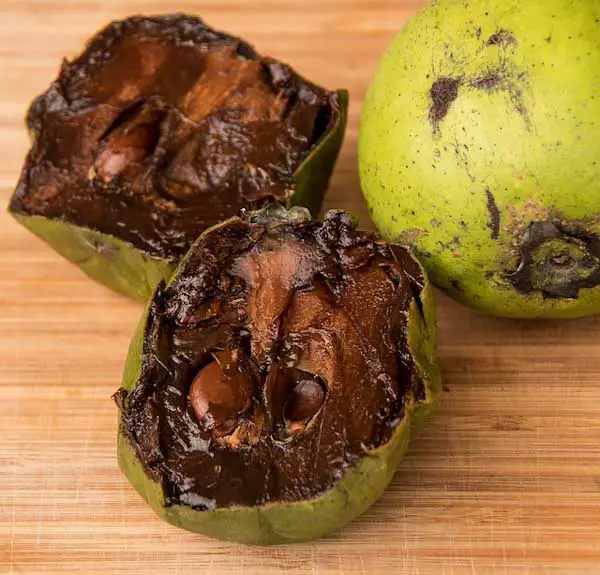
The date plum (Diospyros lotus) is also a member of the persimmon genus. It is native to Iran, Turkey, and southeastern Europe and grows cherry-sized, honey-sweet fruit. The tree typically grows up to 30 feet high and 20 feet wide, although it has been known to reach 90 feet in it’s native Mediterranean region.
When deciding where to plant your persimmon tree, keep in mind its eventual height and width to ensure the tree has enough space. A complication is the fact that most persimmons are dioecious (meaning they have either male or female flowers), so you may need two trees for pollination.
Many home growers with limited space choose to grow Asian persimmons since they naturally have a more compact habit. But there are some things you can do to control the overall size of any persimmon tree.
Can you keep a persimmon tree short?
A persimmon tree can be kept short by pruning. While the tree is young, cut the central trunk to the desired height to encourage branching rather than upright growth. Container planted persimmon trees will also stay smaller due to root restriction.
In general, persimmons don’t need much pruning. Unpruned persimmon trees will still fruit well and look beautiful (especially in fall). But limiting the tree’s size will make the persimmons easier to reach, and can even increase the size and quality of the fruit.
Most persimmon trees grow upright from a central leader or main trunk. They can also be trained in a more shrub-like shape, depending on how high the central leader is off the ground (the shorter, the more shrubby).
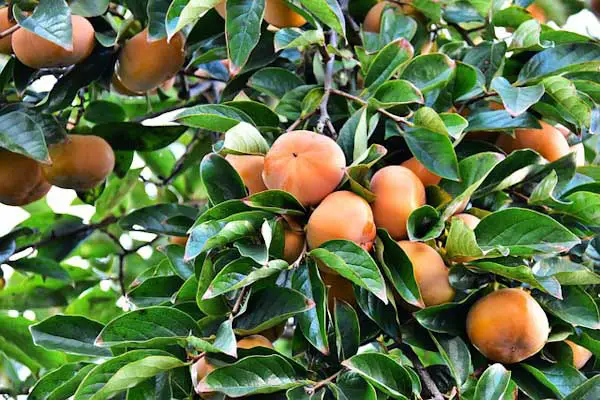
Cut a young tree’s central leader at an angle, to a height of about 4 or 5 feet. The branches that grow off of this main trunk tend to weep or hang downward, especially under the weight of the heavy fruit. If you cut the leader too short, the ripe persimmons may drag on the ground and rot (or get eaten by insects and wildlife).
The fruiting wood grows from the ends of last year’s branches, so avoid heading cuts that remove these buds. If necessary, thin out branches to increase light and airflow. For a great resource on keeping persimmon trees trimmed, visit Pruning an Asian Persimmon Tree in 5 Simple Steps.
Persimmon trees can also be happily grown in pots. It’s recommended to use Asian varieties for container-grown persimmons, as these stay naturally more compact. American persimmons not only grow much larger, but they have a very deep tap root and may have trouble thriving when confined to a pot.
How fast does a persimmon tree grow and fruit?
In general, persimmon trees grow 1 to 3 feet per year. Asian persimmons typically begin producing fruit after 5 to 7 years of growth. American persimmons take 7 to 10 years before fruiting. A grafted persimmon tree will most likely start fruiting earlier, after 3 to 5 years.
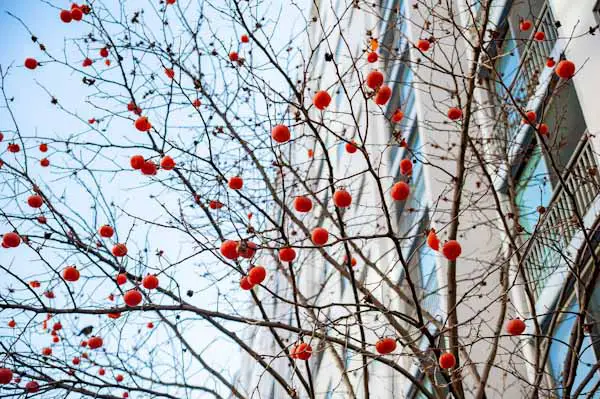
A grafted persimmon tree (where the upper part of one plant has been joined to the rootstock of another) will begin fruiting and grow larger sooner than a non-grafted tree. A tree grown from seed or a small sapling could take even longer to fruit than the average. It’s normal to have a couple of years where the tree blossoms but no persimmons appear, as the tree is still establishing.
American, or common persimmons (D. virginiana) begin fruiting after 7 to 10 years in most cases. However, American persimmons need both a male and female tree in order to be pollinated and produce fruit. If a female tree doesn’t have a male nearby (or vice versa), then it will never grow persimmons. Asian persimmons (D. kaki) fruit sooner than native American varieties, usually after 5 to 7 years.
Related: Persimmon Tree Pollination: Do You Need Two Trees?
It’s recommended to remove young fruit from an immature tree so that it’s energy can be put toward growing and establishing a root system, rather than fruiting. Allowing young trees (Asian persimmons younger than about 7, American persimmons younger than 10, or grafted trees 3 years or younger) to grow without fruiting will result in healthier trees and better persimmon harvests in the long run.
Of course, a tree that is well cared for will have maximum growth and fruiting potential. Luckily, persimmons are one of the easiest fruit trees to grow and are great for beginner gardeners. Read my article Growing Persimmon Trees: How Hard is It? for simple persimmon-growing tips.
A mature, well-established persimmon tree can provide well over 300 pounds of fruit in a season, often as much as 500 pounds or more for an older tree! That kind of result is well worth the wait.

